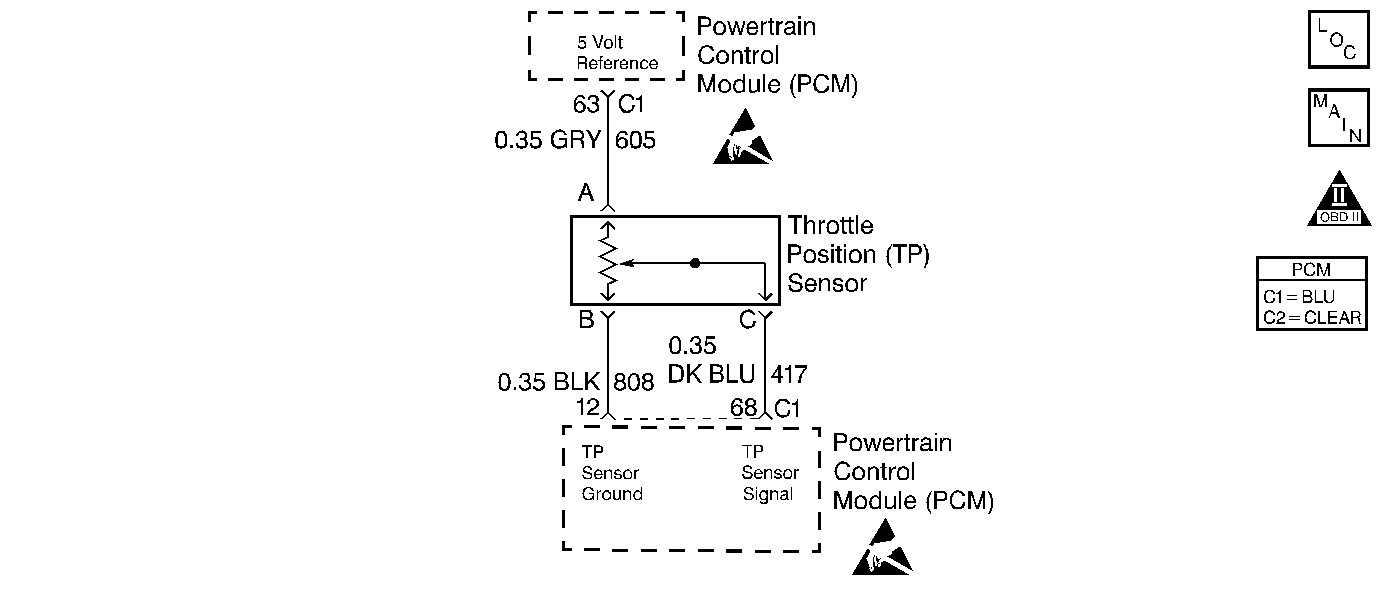
Circuit Description
The Throttle Position sensor is potentiometer. A 5 volt reference is provided on CKT 605 and ground is provided on CKT 808. The TP sensor signal CKT 417 varies between ground and 5 volts based on the position of the throttle plates. At low throttle angle, the TP sensor signal voltage is low. The PCM uses TP sensor information to determine idle, Wide Open Throttle (WOT), deceleration enleanment and acceleration enrichment. DTC P0122 sets when the PCM detects a TP sensor signal that is too low. The PCM tests the TP sensor feedback every 100 ms. If the TP sensor reading is 0.1 volts or less, such as when the signal is open or shorted to ground, the PCM sets DTC P0122.
Conditions for Running the DTC
Engine speed 600 RPM or greater.
Conditions for Setting the DTC
The TP sensor reading is 0.1 volts or less.
Action Taken When the DTC Sets
| • | PCM disables the torque converter clutch. |
| • | PCM calculates a TP sensor value based on MAP and engine speed inputs. |
| • | PCM disables fourth gear. |
| • | The PCM will illuminate the malfunction indicator lamp (MIL) when the diagnostic runs and fails. |
| • | The PCM will record operating conditions at the time the diagnostic fails. This information will be stored in the Freeze Frame and Failure Records. |
Conditions for Clearing the MIL/DTC
| • | The PCM will turn the MIL OFF after three consecutive drive trips that the diagnostic runs and does not fail. |
| • | A Last Test Failed (current) DTC will clear when the diagnostic runs and does not fail. |
| • | A History DTC will clear after forty consecutive warm-up cycles with no failures of any emission related diagnostic test. |
| • | Use a scan tool to clear DTCs. |
| • | Interrupting PCM battery voltage may or may not clear DTCs. This practice is not recommended. Refer to Clearing Diagnostic Trouble Codes in PCM Description and Operation. |
Diagnostic Aids
If fault is not present perform Powertrain Ground Check and also review Failure Rec. to determine conditions under which and how long ago the DTC set.
Test Description
Number(s) below refer to the step number(s) on the Diagnostic Table.
-
With TP sensor or wiring open, TP sensor display will read 0.1 volts or less.
-
Checking for open TP sensor or open wiring. If the display value stays less than 4.96 volts with the TP sensor terminals A and C jumpered together, the problem is in the wiring.
-
Voltage should be greater than 0.5 volt if CKT 605 is not open or shorted to ground.
-
If voltage at TP sensor connector terminal A is 4.5 volts or more, the TP Sensor Signal circuit could be shorted to ground.
-
Use the MAP display to determine if a 5 volt reference problem exists.
-
If there is high resistance, the TP Sensor Signal circuit could be open. If low resistance exists the PCM may be faulty.
-
Checking the 5 volt reference feed to the TP sensor.
The 5 volt reference circuits are shared inside the PCM. A short to ground on any 5 volt circuit will cause several other 5 volt circuits to be grounded also. A short to ground may also occur in one of the components that uses a 5 volt reference.
Check for shorted components before replacing a PCM.
Step | Action | Value(s) | Yes | No |
|---|---|---|---|---|
1 | Did you perform the Powertrain On-Board Diagnostic (OBD) System Check? | -- | ||
Does throttle position read the same or less than the value specified? | 0.1 volts | Fault not present. Refer to Diagnostic Aids | ||
Does TP display read the same or more than the value specified? | 4.5 volts | |||
Using DMM J 39200 measure voltage to ground on jumper. Is voltage less than the value specified? | 0.5 volts | |||
Is voltage the same or more than the value specified? | 4.5 volts | |||
Using a scan tool view the MAP display. Does MAP sensor display read the same or less than the value specified? | 17 kPa | |||
Is the resistance the same or less than the value specified? | 5 ohms | |||
Is either CKT less than the value specified? | 10K ohms | |||
9 | Repair the short to engine ground in the TP Sensor signal circuit or the signal circuit shorted to the ground circuit. Is the repair complete? | -- | Go to Powertrain Control Module Diagnosis for Verify Repair | -- |
10 | Repair the open in the 5 Volt Reference circuit. Is the repair complete? | -- | Go to Powertrain Control Module Diagnosis for Verify Repair | -- |
11 | Repair the open in the TP Sensor Signal circuit. Is the repair complete? | -- | Go to Powertrain Control Module Diagnosis for Verify Repair | -- |
12 | Repair the short to ground on CKT(s) with low resistance. Is the repair complete? | -- | Go to Powertrain Control Module Diagnosis for Verify Repair | -- |
13 |
Was terminal contact repaired? | -- | Go to Powertrain Control Module Diagnosis for Verify Repair | |
14 | Replace the Throttle Position sensor. Refer to Throttle Position Sensor Replacement . Is the replacement complete? | -- | Go to Powertrain Control Module Diagnosis for Verify Repair | -- |
15 |
Was terminal contact repaired? | -- | Go to Powertrain Control Module Diagnosis for Verify Repair | |
16 | Replace the PCM. Refer to Powertrain Control Module Replacement/Programming . Is the replacement complete? | -- | Go to Powertrain Control Module Diagnosis for Verify Repair | -- |
